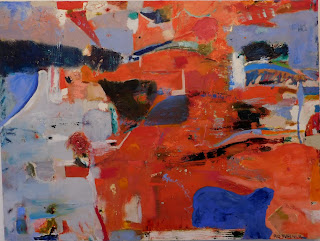One
Language, Two Dialects
 |
| Pale Dawn, by Jeffrey Hull |
 |
| So Easy, by Jeffrey Hull |
 |
| His Very Last Thoughts Lie Here, by Jeffrey Hull |
 |
| 6-1-2013, by Jo Ann Rothschild |
 |
| Little Surprise, by Jo Ann Rothschild |
 |
| July 8, 2019, by Jo Ann Rothschild |
By
Tom Wachunas
“Form itself, even if completely abstract
... has its own inner sound.” ― Wassily
Kandinsky
“… Abstract art enables the artist to
perceive beyond the tangible, to extract the infinite out of the finite. It is
the emancipation of the mind. It is an exploration into unknown areas.” ― Arshile Gorky
EXHIBIT: Parallel
Tracks: Paintings by Jo Ann Rothschild & Jeffrey Hull / at THE
WILLIAM J. AND PEARL F. LEMMON VISITING ARTIST GALLERY at Kent State University
at Stark, Fine Arts Building / 6000
FRANK AVENUE NW, NORTH CANTON, OH 44720
PLEASE
NOTE: I’m
saddened that the Covid-19 situation has shut down Kent Stark campus and thus
access to this exhibit. I simply want to remember and document here that the
exhibit was yet more remarkable evidence of this elegant gallery’s cultural
importance to our region. I’m extremely grateful for the continuing curatorial
endeavors by Professor Jack McWhorter (Kent Stark Fine Arts Dept. Coordinator)
and the impeccable work by Jeff Leadbetter (Kent Stark Fine Arts Equipment
Laboratory Technician) in installing all these exhibits.
Most of the works featured
in this captivating exhibit – by Boston-based
Jo Ann Rothschild, and Jeffrey Hull, who lived and worked in Boston’s South End
from 1979 until his death in 2017 - are abstract paintings. Rothschild and Hull
speak the same language, which is to say they’ve consciously applied moistened
pigments to a flat surface - a two-dimensional picture plane. They employ the
same rudimentary vocabulary elements of color, shape, and line. But beyond
their basic “grammar,” their style of syntax as well as ostensible subject
matter make for very divergent dialects. Talk about different strokes…
In some ways, Jeffrey
Hull’s paintings recall the transcendence, or spirituality, resonant in the 20th
century Modernist landscapes by American painters such as Marsden Hartley,
Arthur Dove and, more recently, the boldly-colored visions of Gregory Amenoff. Hull’s iconography, however, while at times
suggestive of strange terrains dense with with tangled natural forms, is a bit
more enigmatic and surreal, exuding an intensely personal sort of mysticism.
Pale Dawn and So Easy (both acrylic on canvas) are loosely painted clusters of
biomorphic and angular shapes that look like they’re bundled together. Or
pulled apart? Hard to tell which,
actually. It’s a chimeric ambiguity that draws you in and keeps you looking.
Some configurations in these mindscapes look
like multicellular organisms undergoing mitosis, or mutation. In these works, one
passage – whether doodled gesture,
defined pattern, or contoured form – can often seem to be an automatic reply to
an adjacent passage of a wholly different character. One mark or shape or color
can call its immediate neighbor into being. Ses
dernières pensées se trouvent ici (His very last thoughts lie here) #10 (oil
on canvas) employs a more rigid linearity in how the varying shapes are joined.
Additionally, Hull’s dazzling color acuity, and the carved texture of his
sumptuous impasto surface, give the painting a sculpted, even architectural
presence.
The notion of
painterly intuition - allowing one visual element to bring another into being
(mentioned above in reference to Hull) - is a call-and-response dynamic also
evident in the paintings by Jo Ann Rothschild. That said, her pictorial motifs
are decidedly more diffuse and nondescript than we see in Hull’s paintings.
Paintings such
as 6-1-2013 (oil on canvas, named for
the date of its completion), and Little
Surprise (oil on linen), seem at first to have been made quickly, all at
once. But look deeper through the veils of brushy, energetic paint movement,
both visceral and gentle. Belying that
appearance of instant spontaneity is a history, a sense of flux. Actions and
reactions. Colors, shapes, and marks have been altered, their rhythms re-arranged
and re-ordered over time. You could think of Rothschild’s picture planes as
evolving improvisatory melodies, with some passages sung softly, like distant
echoes, others with real gusto, embellished with bright staccato accents. Songs
about old things fading away and new things emerging.
Some of her
oil paintings here are very small (9 x 12 inches), such as July 8, 2019. “Small paintings surprise and interest me,” she wrote
in her statement. “In a time of big lies. I want modest truth.” Despite their
modesty of physical scale, they still sing in a big way.
Overall, the
exhibit reminded me once again that my deep appreciation of abstract painting,
in all its dialects, is rooted in willingness to look long and look slowly.
That very act is its own reward. I can assure you that in the future, Kent
Stark’s Lemmon Gallery will continue offering vigorous journeys to perceptual thresholds
beyond the ordinary.


No comments:
Post a Comment